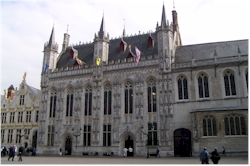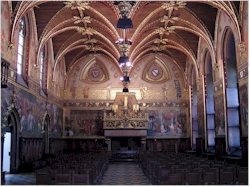|
Picture: the gothic room in the town hall of Bruges |
|
» Eating » Sleeping facilities » Going out in Bruges » Fixed events » Beguinage » Belfry and halls » Chapel of the Holy Blood » Court of the Princes » Dunes abbey » Guild houses of Bruges » Hospices of Bruges » Jerusalem church » Nation houses » Our Ladies church » Poortersloge » St-Anna's church » St-Donatian's cathedral » St-John's hospital » St-Saviour's cathedral » Town gates » Town hall » Windmills of Bruges » Complete overview... » Archeology museum » Brangwyn museum » Brewery museum » Chocolate museum » Diamant museum » Folklore museum » Frites museum » Groeninghe museum » Guido Gezelle museum » Halve Maan » Lace museum » Lamps museum » Memling museum » Museum of Fine Arts » Salvador Dali museum » St-Janshuismill » St-John's hospital » Complete overview... » Boterhuis » Boudewijn Seapark » Burg » Canals (Reien) » Coupure » De Garre » Grote Markt » Historium » Huidevettersplein » Jan Van Eyckplein » Lake of Love (Minnewater) » Rozenhoedkaai » Simon Stevinplein » 't Zand » Complete overview...
|
The town hall
Brief history. At first the town council assembled in the belfry tower where they had their meeting room. Due to a fire in 1280 however, they had to find another location. They moved to the "ghyselhuys" (a former prison) that served as town hall for a bit less than a century. At the end of the 14th century, the ghyselhuys was demolished to make place for a new town hall. The building was ready in 1421. The present town hall largely dates back to 1421, although there were some alterations during its life (enlargements, adaptations to new needs, decorative changes,...). The eye-catchers of the building are the facade and the so-called gothic room.
The "gothic room" is actually not gothic but neo-gothic. After a fire turned the interior largely to rubble, it had to be refurbished. That project started in 1890 and was finished in 1905. The result is stunning with a massive decorative mantelpiece, a double polychrome pending wooden ceiling, wall paintings depicting historic events from the history of Bruges and large number of other decorative elements. Location: Burg 12 Picture 1: façade of the town
hall seen from the Burgplein
|
» getting to Bruges » transport, tours, links,...
|
|
© xplorengo.com. Information is provided from the location and various sources, we do not hold any responsibility with regard to information provided by others. xplorengo is not a travel agency and does not promote or organize trips we therefore hold no responsibility with regard to third parties that promote their services via us. No information or pictures can be copied or distributed in any way without written permission of xplorengo.com. All pictures are made and copyrighted by Hendrik De Leyn unless mentioned otherwise [Contact information]. |
 General. The town hall of Bruges is one of the
oldest in the Low Countries and stood example for several town
halls that were erected in other towns afterwards. The building
was completed in 1421 but enlarged and adapted to the needs in
the centuries that followed. The facade is richely decorated
with gothic windows, towers, statues and the coat of arms of
subordinate towns. Inside you should not miss the impressively
decorated gothic room. There is also a museum on the ground
floor.
General. The town hall of Bruges is one of the
oldest in the Low Countries and stood example for several town
halls that were erected in other towns afterwards. The building
was completed in 1421 but enlarged and adapted to the needs in
the centuries that followed. The facade is richely decorated
with gothic windows, towers, statues and the coat of arms of
subordinate towns. Inside you should not miss the impressively
decorated gothic room. There is also a museum on the ground
floor. The facade is adorned with a
large number of statues depicting biblical figures and rules of
Flanders. These statues are not the original ones; those
were destroyed in 1792 during the French occupation at the end
of the 18th century. Once the occupation was over, new
statues were carved but due to an inferior quality of the
materials, they soon had to be replaced. It eventually
took till the 80's of the last century before all statues were
renewed. The facade also shows the coat of arms of
subordinate towns. Those coat of arms were also removed
during the French occupation and replaced afterwards.
The facade is adorned with a
large number of statues depicting biblical figures and rules of
Flanders. These statues are not the original ones; those
were destroyed in 1792 during the French occupation at the end
of the 18th century. Once the occupation was over, new
statues were carved but due to an inferior quality of the
materials, they soon had to be replaced. It eventually
took till the 80's of the last century before all statues were
renewed. The facade also shows the coat of arms of
subordinate towns. Those coat of arms were also removed
during the French occupation and replaced afterwards.